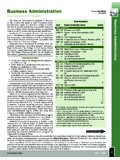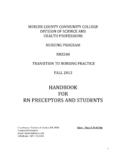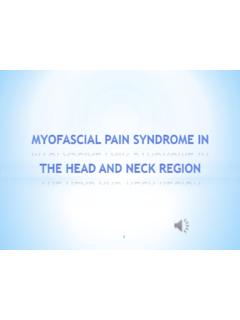Transcription of Burn Classification - MCCC
1 8/26/2013 1 burn Classification Burns are classified by: Cause Depth Extent (the rule of nines) Types of Burns: CAUSE Thermal burn : caused by conduction or convection Ex. Hot liquid, fire or steam Electrical burn : caused by the passage of electrical current through the body. There is typically an entrance & an exit wound. Ex. lightning Chemical burn : occurs when certain chemical compounds come in contact with the body. Ex. Sulfuric acid, lye, hydrochloric acid, gasoline 8/26/2013 2 Depth of Injury Traditional: 1st degree, 2nd degree, 3rd degree We now use Modern terminology: Superficial: involves only the outer epidermis; heals without scarring Superficial Partial-Thickness: involves epidermis & the upper portion of the dermis; pain & blisters; heals with min to no scarring Deep-Partial Thickness: complete destruction of the epidermis & the majority of the dermis; blisters, edema.
2 May heals with hypertrophic scars & keloids Depth of Injury Continued Full-Thickness: complete destruction of the epidermis & dermis along with partial damage of the subcutaneous fat layer; require grafts & susceptible to infection Subdermal: complete destruction of the epidermis, dermis, & subcutaneous tissue; may involve muscle often requires surgical intervention Zones of Injury Zone of Coagulation: area of greatest destruction, tissue necrosis, irreversible cell damage Zone of Stasis: damaged tissue, area of less severe injury that possesses reversible damage and surrounds the Zone of Coagulation Zone of Hyperemia.
3 Pink, no cell death, the area surrounding the Zone of Stasis that presents with inf lammation, but will fully recover without any intervention or permanent damage 8/26/2013 3 Criteria for Hospitalization 20% or greater TBSA (total body surface area) 10% or greater TBSA in child or older adult 5% or greater full thickness burn Burns to any of the 4 special areas Burns to the eyes or ears 4 Special Areas If any of the 4 special areas are burned, it is classified as a severe burn and will require hospitalization Special areas: face, hands, feet, groin 8/26/2013 4 Estimation of burn Size ADULTS: RULE OF NINES for calculating TBSA Head & neck 9 % Anterior trunk 18 % Posterior trunk 18 % Bilateral anterior arm, forearm and hand 9 % Bilateral posterior arm, forearm and hand 9 % Genital region 1 % Bilateral anterior leg and foot 18 % Bilateral posterior leg and foot 18 % Estimation of burn Size Children: Lund-Browder Classification (used for calculating TBSA) A child under one year has 9 % taken from the lower extremities and added to the head region.
4 Each year of life, 1 % is distributed back to the lower extremities until age 9 when the head region is considered to be the same as an adult. 8/26/2013 5 burn Shock & Vitals burn Shock is a complex clinical syndrome that may develop. Characterized by massive f luid loss Cardiac output may be decreased by 50% for the first 2-4 days Decreased circulating blood volume, but the red blood cells remain and blood f low is even further slowed due to it s viscosity burn Shock & Vitals Vitals Blood pressure generally decreases Within hours of a burn injury, patients develop sinus tachycardia in an attempt to maintain cardiac output at an acceptable level.
5 Ideally, adults should have a resting heart rate between 100-120 bpm and children 120-170 bpm. This increased resting HR means lower cardiac reserves for increased activity (PT). PT Intervention #1. Prevention of Secondary Complications: A. B. C. D. E. 8/26/2013 6 PT Intervention continued #2. Wound Care #3. Scar Management burn scars require 6 mo 2 yrs to mature Might include gentle moisturizing, gentle scar massage , compression wraps and garments, silicone pads for small areas #4. Therapeutic Exercise ROM Gait training and mobility Breathing exercises Aerobic exercises PT Intervention continued #5.
6 Positioning To enhance wound and scar healing To reduce edema To prevent contracture To prevent pressure wounds To improve pulmonary function Body area Contracture predisposition Preventive positioning Neck f lexion Extension Anterior axilla Shoulder add Shoulder abd Posterior axilla Shoulder ext Shoulder f lex Antecubital space Elbow f lexion Elbow extension Forearm pronation Supination Wrist f lexion Extension Dorsal hand / finger MCP hyperextension IP f lexion Thumb add MCP f lexion IP extension Thumb abd Hip Flexion, add, ER Ext, abd, IR Knee f lexion Extension Ankle PF DF 8/26/2013 7 8/26/2013 8 8/26/2013 9 Questions?
7 ? Giles, , (2010), PTA EXAM The Complete Study Guide, Scorebuilders: Scarborough, Maine. Myers, , (2004), Wound Management: Principles and Practive, Prentice Hall: Saddle River, NJ.










